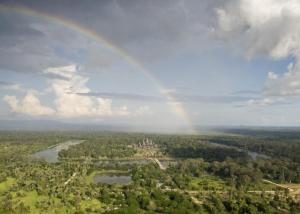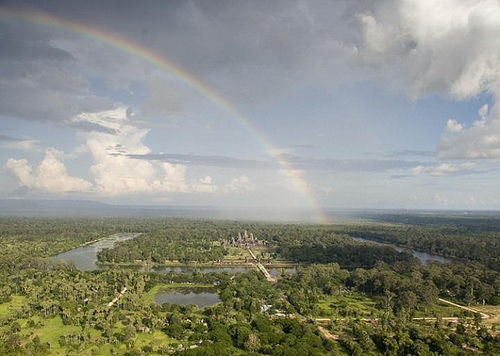
UNIVERSITY OF SYDNEY—The temple of Angkor Wat was much larger and more complex than previously thought, University of Sydney archaeologists have discovered.
The University of Sydney’s Professor Roland Fletcher and Dr Damian Evans lead the Greater Angkor Project in Cambodia, a major international research collaboration which is using airborne laser scanning (LiDAR) technology, ground-penetrating radar and targeted excavation to map the great pre-industrial temple.
The landscape of Angkor Wat redefined
The team has discovered that the Angkor Wat complex was far larger than expected, had more components than previously envisaged, and was bounded on its south side by a unique and massive structure.
“This structure, which has dimensions of more than 1500m×600m, is the most striking discovery associated with Angkor Wat to date. Its function remains unknown and, as yet, it has no known equivalent in the Angkorian world,” said Professor Fletcher, from the University’s Department of Archaeology.
The team also discovered Angkor Wat included an entire ensemble of buried ‘towers’ built and demolished during the construction and initial use of the main temple, remains of what is thought might be a shrine used during the construction period.
Roads and homes hint at workers’ role
The areas surrounding Angkor Wat have long been assumed to be sacred precincts or ‘temple-cities’. However, the research has revealed evidence of low-density residential occupation in the region, including a grid of roads, ponds and mounds, possibly used by people servicing the temple.
“This challenges our traditional understanding of the social hierarchy of the Angkor Wat community and shows that the temple precinct, bounded by moat and wall, may not have been exclusively the preserve of the wealthy or the priestly elite,” said Dr Fletcher.
____________________________________________
View over Angkor Wat from the west, looking towards the Kulen hills; the extent of one quarter of Greater Angkor is indicated by the distance between Angkor Wat and the north-eastern outer edge of the urban complex near the grey line of the base of the hills. Image courtesy of Mike Coe.
_____________________________________________
Fortifications offer clues about Angkor’s demise
The team has also discovered that Angkor Wat was fortified with wooden structures sometime late in its history. Dr Fletcher said the results reveal how Angkor Wat may have made its last attempt at defence.
“Angkor Wat is the first and only known example of an Angkorian temple being systematically modified for use in a defensive capacity,” he said.
“The available evidence suggests it was a late event in the history of Angkor, either between AD 1297 and 1585, along with other defensive works around Angkor, or perhaps sometime between AD 1585 and the 1630s, representing a final attempt to defend Angkor against the growing influence of [neighbouring city] Ayutthaya. Either date makes the defences of Angkor Wat one of the last major constructions at Angkor and is perhaps indicative of its end.”
The team’s latest discoveries are published in this month’s issue of the journal Antiquity.
______________________________________________________
In addition, the latest Popular Archaeology ebook is now available.
______________________________________________
Travel and learn with Far Horizons.
____________________________________________
This richly illustrated issue includes the following stories: Two remarkable discoveries that are shedding light on human beginnings in Africa; a traveling exhibit and an archaeological site that show how knowledge is more valuable than gold; a Spanish cave and a unique burial that are offering a tantalizing glimpse on the lives of Ice Age hunter-gatherers in Europe; the stunning visual reconstruction of an ancient Roman town; enlightening new finds at a remarkably well-preserved site of ancient Hellenistic-Roman culture overlooking the Sea of Galilee; rare finds that are shedding light on occult practices among ancient Greeks in Sicily; and an overview of the overwhelmingly rich archaeological heritage of Britain. Find it on Amazon.com.










